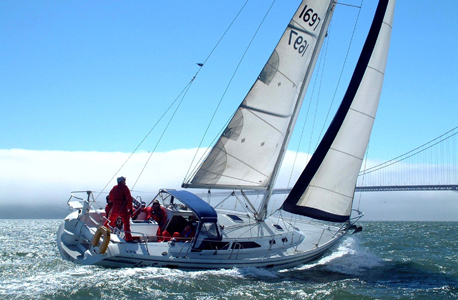For thousands of years, ships at sea have lived with the rhythm of the watch. The off-going watch reports the situation aboard and, together, the off-going and the on-coming watch consider what (if anything) needs to be done during the next watch.

Photo courtesy of OCSC Sailing
By CaptaIn Ray
Published: February, 2013
For thousands of years, ships at sea have lived with the rhythm of the watch. The off-going watch reports the situation aboard and, together, the off-going and the on-coming watch consider what (if anything) needs to be done during the next watch. The off-going watch then "officially" transfers responsibility of the vessel to on-coming watch. This system is necessary because the vessel is underway continuously.
We follow the watch system when teaching sailing classes that involve several days of continuous sailing. Some years ago, Captain Phil and I were co-skippers/instructors on a seven-day Ocean Passage Making course. On the first day, we sailed up to Drakes Bay and anchored for the night, giving the students a chance to get accustomed to the motion of the boat, find out where the handholds were, and for all of us to have one last, uninterrupted night’s sleep.
We departed Drakes Bay the next morning, planning to spend four days continuously underway out of sight of land, between approximately 60 and 200 miles offshore. Our six-person crew was divided into three watches and, for the next four days, they would be standing three hours on and six hours off. Captain Phil and I would be standing four hours on, four hours off for those four days.
We chose to do the hard part first. Sailing upwind, that is, into the waves and wind, is usually a more difficult and uncomfortable point of sail—that’s why it’s called "beating." Sailing across the wind ("reaching") or with the wind ("running") typically is much more comfortable and much drier. Because the wind was coming from the northwest, we would sail upwind (the harder part) and stay north of the Golden Gate so that it would be downwind (the easier part) at the end of the passage.
The first two days went as planned. The wind was 12 to 15 knots, seas three to five feet and the boat was sailing easily, making a bit over seven knots. We began sailing with the wind on the starboard (or right) side of the boat and our course 265M (or just south of west). As we approached the 200-mile limit, we tacked. With the wind now on the port (or left) side of the boat, we were able to make our northing. We were comfortably holding a course of 005M, almost exactly due north.
Then the weather started to deteriorate. As the wind came up and the seas began to build, the boat’s motion became more uncomfortable and steering more difficult. To help with both of these issues, I had the jib (the forward sail) rolled partially and the first reef put in the main. With my watch ending at midnight, I went below, woke Phil, reported the changes and transferred responsibility. Then I went to sleep—which is the duty of those off-watch. Three hours and 45 minutes later, Captain Phil woke me with the following report, delivered with a certain amount of wry mirth:
"There are no vessels in sight and the radar shows one vessel passing eight miles astern. The seas are 15 feet and breaking. The wind is a steady 25 knots with gusts to 30 plus. The National Weather Service has just posted gale warnings on the radio. We’ve taken in more of the jib and tucked the second reef into the main. I’ve altered course to ease the boat’s motion, but we are now down to the latitude of the Gate. Two-thirds of the crew are actively vomiting. There appears to be a charging problem in the electrical system. It’s your watch, Skipper!"
Ray Wichmann, is a US SAILING-certified Ocean Passagemaking Instructor, a US SAILING Instructor Trainer, and a member of US SAILING’s National Faculty. He holds a 100-Ton Master’s License, was a charter skipper in Hawai’i for 15 years, and has sailed on both coasts of the United States, in Mexico, the Caribbean, and Greece. He is presently employed as the Master Instructor at OCSC Sailing in the Berkeley Marina.

